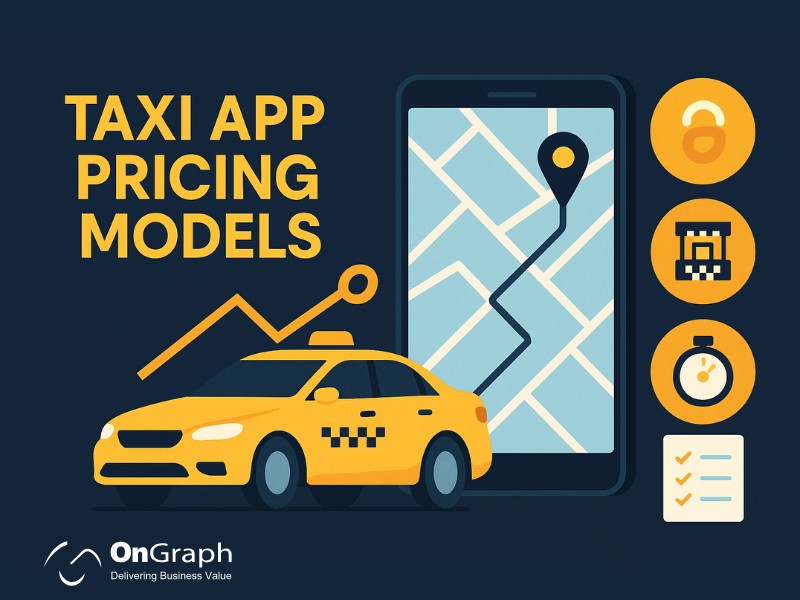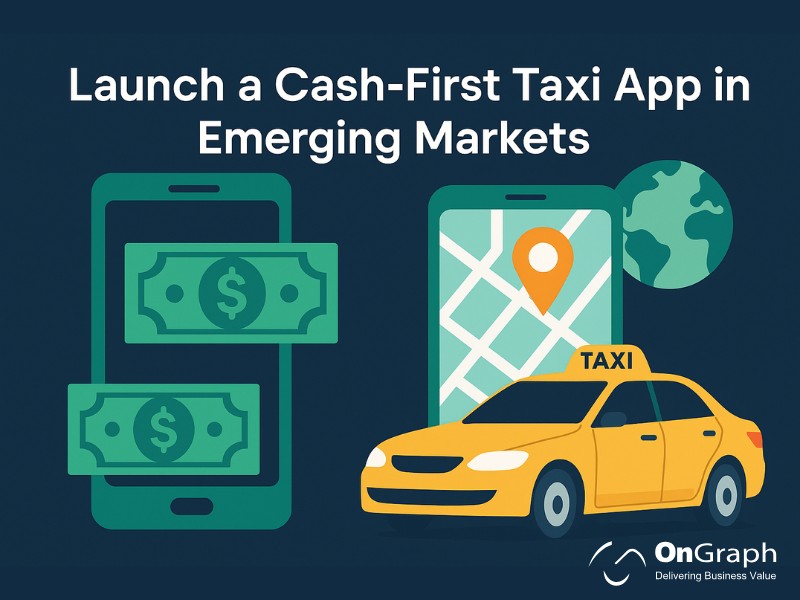In this article
- Why Pricing Models Matter in Ride-Hailing?
- Core Components of Taxi Fare: What to Price?
- Model 1: Distance-Based + Time-Based Fare
- Model 2: Toll & Surcharge Aware Pricing
- Model 3: Dynamic Pricing & Surge — Meet Demand Peaks
- Model 4: Region-Wise and Multi-City Pricing Strategy
- Model 5: Fare Estimation Algorithm & Taxi Meter App Integration
- Why Smart Pricing Models Are Critical — Industry & Market Data
- Technical & Operational Best Practices for Implementing Pricing Models
- Potential Pitfalls & How to Avoid Them
- When You Should Use a Custom Fare Engine vs Off-the-Shelf Solutions
- Summary: How to Choose the Right Taxi App Pricing Models
The success of any ride-hailing business greatly depends on well-designed Taxi App Pricing Models. A transparent and flexible pricing engine that covers tolls, surge, distance, and time can boost revenue, driver availability, and user trust.
In this article, we explain how to build a region-wise fare engine. We cover distance-based pricing, time-based fare structures, surge multipliers, toll fare calculation, and dynamic pricing. We provide real-world data, case studies, and best practices.
Why Pricing Models Matter in Ride-Hailing?
The global ride-sharing market continues to grow rapidly. In 2023, it was valued at USD 106.66 billion, and projections estimate it will reach USD 480.09 billion by 2032, with a CAGR of ~18.5%.
In 2024 alone, app-based taxi services worldwide generated USD 59.6 billion in revenue.
With such scale, small pricing errors can lead to big revenue loss — or dissatisfied customers. A robust fare calculation model ensures:
- Fair and transparent pricing for riders
- Proper driver incentives (especially in surge/toll zones)
- Compliance with regional fee structures and tolls
- Scalability as the app expands to new cities
Thus, choosing the right Taxi App Pricing Models becomes a core business decision.
Core Components of Taxi Fare: What to Price
Any fare calculation engine typically includes a combination of:
- Base fare — fixed starting cost for every ride.
- Distance-based pricing — cost per mile/km traveled.
- Time-based fare structure — cost per minute/hour of ride or waiting time.
- Toll or surcharge fees — additional fees for tolls, airport pickups, night/time-based charges.
- Dynamic pricing (Surge / Peak hour pricing) — variable multiplier during high demand or low supply.
- Minimum fare / Cancellation fee / Waiting charges — safety nets for very short rides or cancellations.
Combining these correctly — and making them flexible — builds a powerful region-wise pricing engine.
Model 1: Distance-Based + Time-Based Fare
The most common method for calculating ride fare is combining distance-based pricing and a time-based fare structure.
How it works
1. Set a base fare (e.g., $2).
2. Add cost per kilometer/mile (e.g., $0.80/km).
3. Add cost per minute (e.g., $0.25/min) — useful for slow traffic or waiting time.
4. Optionally, include a minimum fare (to prevent extremely short rides from being too cheap).
This model works well in cities with consistent traffic patterns. It’s simple, transparent, and easy to explain to riders.
Limitations
- Does not account for regional variations (e.g., toll zones, airports).
- In high-demand scenarios or peak hours, fixed rates may lead to long waiting times or insufficient driver supply.
- Doesn’t incentivize drivers during traffic-heavy hours.
Hence, distance-plus-time pricing often serves as a baseline — combined with surges and toll logic for real-world viability.
Model 2: Toll & Surcharge Aware Pricing
Many cities have tolls, highway fees, airport surcharges, or night charges. Fare engines must support toll fare calculation and additional fees.
Why it matters
- Tolls can significantly increase the ride cost. Without toll logic, drivers may lose money, or the ride cost may be underpriced.
- Airports often require additional fees (parking, waiting time, luggage handling).
- Regional pricing can differ by city, state, or country (distance units, local taxes, currency).
How to implement
- Map-based toll detection: Use map APIs to detect if the route includes toll roads, and automatically add the toll amount.
- Admin-configurable surcharge list: Maintain a table of city-wise surcharges — e.g., airport pickup fee, night pick-up fee, luggage charge.
- Driver-side manual toll entry (fallback): In case map detection fails, the driver can manually enter the toll amount, which is then added to the fare.
- Transparent fare breakdown: Show riders’ base fare, distance/time fare, tolls, surcharges, and total; maintain trust and clarity.
This method aligns with what many successful ride-hailing platforms use today.
Model 3: Dynamic Pricing & Surge — Meet Demand Peaks
Static pricing fails when demand spikes (rush hour, weather events, holidays). That’s where the dynamic pricing taxi app logic comes in.
What is a surge pricing algorithm
When demand exceeds supply in a zone, the app increases fares using a multiplier (e.g., 1.5x or 2x). This encourages more drivers to accept rides and balances the market.
Real-world impact
- A study showed that adding surge factor improves demand-prediction accuracy by 12–15%.
- The same study found that with surge-aware dispatching, average vacant time for drivers dropped by 9.4% and the average number of trips per taxi rose by ~2.6%.
- Another empirical model in NYC found that dynamic pricing increased revenue by 5–6%, serving 3–4% more passengers than static fare schedules.
Implementation best practices
- Define demand-supply threshold triggers for surge (e.g., > 20 ride requests per minute with < available drivers)
- Use geozone-based surge zones — e.g., downtown, airport, event area
- Display surge rate to user before booking, not after — transparency builds trust
- Limit the maximum surge multiplier to avoid shocking fares and negative publicity
Dynamic pricing can significantly improve service availability while maximizing fleet utilization.
Model 4: Region-Wise and Multi-City Pricing Strategy
If your taxi app operates in multiple cities or countries, you need a regional pricing engine.
Key challenges
- Distance units: miles vs kilometers.
- Local taxes, regulatory charges, and toll rates differ.
- Currency and payment gateway variations.
- User expectations vary: what’s “cheap” in one city may be “expensive” in another.
Recommended design
- Configurable currency and units — each city profile includes its currency and distance unit.
- City-specific fare rules — define base fare, per km/min, minimum fare, surcharges, toll logic per city.
- Geo-fencing for service areas — restrict ride requests to allowed zones; helpful for regulatory compliance and demand management.
- Admin control panel — allow operations team to update fare rules, surcharges, tolls without redeploying code.
This makes your fare engine scalable and flexible across regions.
Also read- How to Build a Region-Wise Pricing Engine in Your Taxi App?
Model 5: Fare Estimation Algorithm & Taxi Meter App Integration
Modern taxi apps need to show riders a fare estimate before booking. A well-built fare estimation algorithm gives transparency and builds trust.
How to build a fare estimator
- Use route distance & estimated time (from map API)
- Add base fare + distance fare + time fare
- If toll roads are detected, run toll fare calculation and include tolls
- Add possible surcharges (night, airport, event, etc.) as per city/zone rules
- If current demand triggers a surge, apply the surge multiplier to base, distance, and time fares
Many ride-hailing platforms combine this with real-time map + taxi meter app integration, so the driver sees the same fare logic, and tracking remains consistent.
Why Smart Pricing Models Are Critical — Industry & Market Data
- In 2024, taxi apps generated USD 59.6 billion in global revenue — up 27.6% YoY.
- The overall global taxi market (including app and non-app services) was valued at USD 252.80 billion in 2024.
- With the rising adoption of app-based ride-hailing, many operators switch from phone dispatch to app dispatch. Efficient fare models help them stay profitable and competitive.
- Research shows that surge-based demand modeling reduces idle time and boosts trip count per taxi — improving fleet productivity.
These data reaffirm that building a robust, dynamic, toll-aware fare engine is not optional — it is essential.
Also read- Taxi App Development Cost in 2025: Full Budget Guide
Technical & Operational Best Practices for Implementing Pricing Models
Here are actionable guidelines for development teams and operations managers:
| Practice | Why It Matters |
| Build a fare engine as modular & configurable | Makes adjustments easier per city, toll rule, currency, etc. |
| Maintain an admin panel for fare configuration | Non-technical staff can update pricing without code changes |
| Use map APIs + toll databases for accurate route & toll detection | Prevents undercharging or driver losses |
| Implement a transparent fare breakdown for users | Builds trust and reduces complaints |
| Add waiting time, cancellation, and minimum fare logic | Protects from losses on short rides or cancellations |
| Define surge zone thresholds and caps | Controls extreme fare spikes and avoids consumer backlash |
| Test fare estimation vs actual fare — end-to-end QA | Prevents mismatches and driver/rider disputesPotential Pitfalls & How to Avoid Them |
Potential Pitfalls & How to Avoid Them
1. Very aggressive surge multipliers — can lead to rider dissatisfaction.
- Fix: cap maximum multiplier, or use soft surge (modest increment).
2. Incorrect toll detection — some map APIs may miss toll links.
- Fix: allow driver manual input, or maintain a toll-road database per city.
3. Frequent fare changes causing confusion — leads to user distrust.
- Fix: avoid frequent changes; publish change logs; notify users clearly.
4. Inconsistent fare across driver and rider apps — can cause disputes.
- Fix: same fare engine for rider and driver clients; fare estimation algorithm also used on the driver side.
5. Regulatory & compliance risk in multi-city operations — each region may have different taxi-fare regulations.
- Fix: add a compliance module; allow admin to set region-wise regulation rules.
By being aware of these pitfalls and applying preventive measures, your taxi platform can remain robust and trusted.
When You Should Use a Custom Fare Engine vs Off-the-Shelf Solutions
If you just want to launch quickly with minimal customization, off-the-shelf fare modules (offered by many taxi app platforms) might work.
However, you should build a custom fare engine when:
- You operate across multiple cities/countries with different tolls, currencies, and units
- Require complex surcharges (airport fees, event fees, night charges)
- Want full control over the surge algorithm, fare estimation, and admin overrides
- Plan to integrate with local payment gateways, wallet systems, or cash-first models
Given the scale and flexibility required for a reliable taxi business, most serious operators benefit from a bespoke fare engine.
Summary: How to Choose the Right Taxi App Pricing Models
- Use distance + time pricing as baseline — simple, transparent.
- Add toll fare calculation and surcharge logic for real-world compliance.
- Implement surge / dynamic pricing to balance supply–demand and improve driver availability.
- Build a region-wise pricing strategy — configurable per city, currency, units, and surcharges.
- Provide a fare estimation algorithm + transparent breakdown for riders.
- Maintain an admin panel for flexibility and quick updates.
- Test thoroughly and include safeguards (caps, fallback rules, driver/rider transparency).
These building blocks of Taxi App Pricing Models will create a robust, scalable, fair pricing engine. A reliable Taxi App Development Company will ensure these elements work together seamlessly, helping you build a robust, scalable, and fair pricing engine.
FAQs
Most taxi apps use a mix of distance-based pricing and time-based fare structure as a baseline. Then they layer on toll fare calculation (for toll roads, airports, night surcharges, etc.) and dynamic pricing (surge / peak hour pricing) when demand fluctuates. This hybrid approach balances fairness, transparency, and operational efficiency.
Surge pricing activates when demand outpaces supply in a zone. The app applies a surge multiplier (e.g., 1.5x, 2x) to the base fare, distance rate, and time rate. This attracts more drivers, reduces wait times, and balances supply-demand. Trigger criteria are typically defined by number of pending ride requests vs available drivers in a zone. Surge should be capped to avoid extreme fares and used transparently.
Use a map API to detect toll roads and automatically add toll fare. Maintain a configurable list of surcharges per city (airport fees, night charges). Also provide driver-side manual input option if automatic detection fails. Show fare breakdown clearly to riders (base fare, distance fare, time fare, tolls/surcharges, total).
Build a region-wise pricing engine. For each city/region store parameters: currency, distance unit (km/miles), base fare, per km/min rate, minimum fare, surcharge rules, toll rules. Use geo-fencing to restrict service areas. Provide an admin panel so operations teams can manage pricing without redeploying code.
Yes. A fare estimation algorithm improves transparency and trust. It uses map-based distance and time estimates, toll detection, applicable surcharges, and predicted surge multipliers. Displaying a fare estimate (or a fare range) helps reduce cancellations or disputes and improves user experience.
Empirical studies show yes. Surge-aware pricing and dispatch reduced driver idle (vacant) time by ~9.4% and increased trips per taxi by ~2.6%. ResearchGate+1 In model tests (e.g., NYC), dynamic fare schedules yielded 5–6% more revenue and served 3–4% more passengers compared to static fares. caee.utexas.edu
Build a custom fare engine when: you plan to operate across multiple cities/countries, need support for varying toll/surcharge rules, want full control over surge logic, need transparent fare breakdown, or expect frequent fare rule changes. Custom engines give flexibility, scalability, and regulatory compliance — essential for serious taxi/ride-hailing businesses.
About the Author
Let’s Create Something Great Together!
Latest Blog















